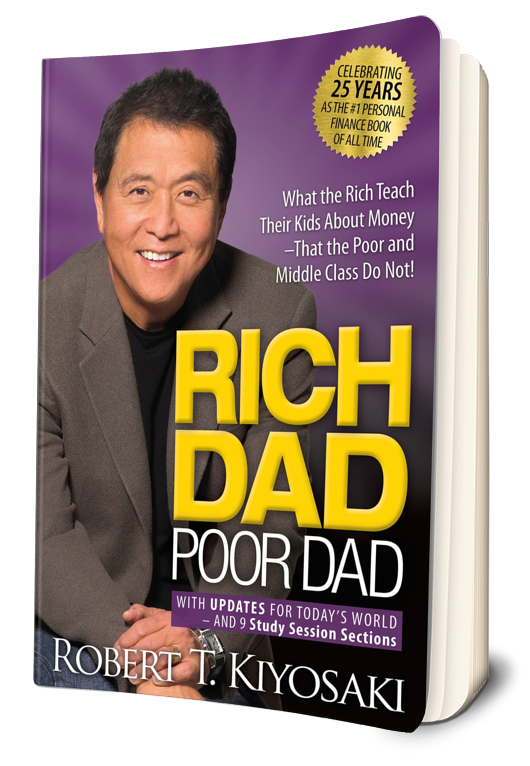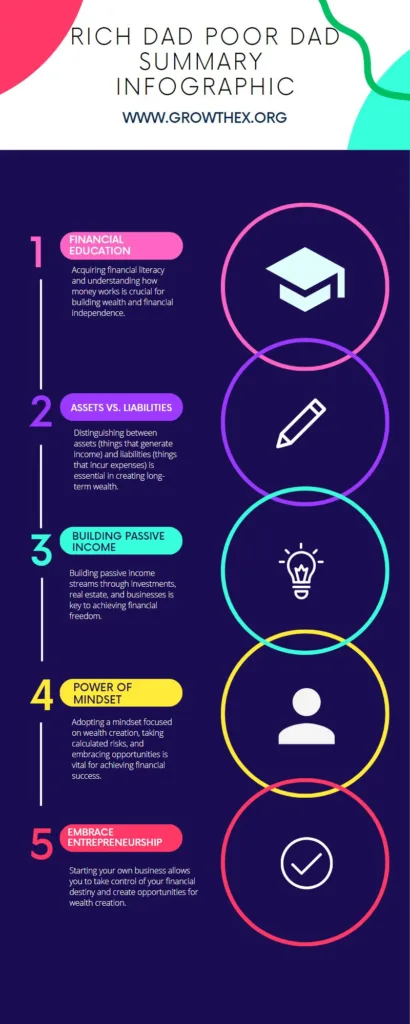Robert Kiyosaki’s “Rich Dad Poor Dad” is more than simply a book about money; it’s a manual for changing your perspective and revealing the keys to financial success. Kiyosaki creates a compelling narrative that questions popular belief about wealth and offers a road map for reaching financial independence by drawing on his personal experiences and comparing the teachings of his two prominent father figures.

In this book, Kiyosaki tells the tale of his “poor dad,” a highly educated biological father who battled with money, and his “rich dad,” the shrewd businessman father of his closest friend. Through these divergent viewpoints, Kiyosaki illuminates the mentality and methods that distinguish the wealthy apart from the middle class.
This engaging beginning lays the groundwork for a transformative trip that will test your assumptions about money, employment, and the way to financial freedom. With the help of real-world examples and doable advice, Kiyosaki’s open and approachable writing style makes a strong argument for taking charge of your financial future.
Insights and principles from “Rich Dad Poor Dad” inspire readers to rethink how they acquire wealth, make investments, and develop stable sources of income. Kiyosaki asserts that he can help you move towards a more prosperous financial future by helping you reevaluate your relationship with money and adopting the mindset of the wealthy.
Prepare to dive into the pages of “Rich Dad Poor Dad” and start a journey of financial empowerment and enlightenment. The insights found here could change your financial direction and put you on the road to long-term prosperity.
The Contrast of Rich Dad and Poor Dad
In the opening chapter of “Rich Dad Poor Dad,” Robert Kiyosaki introduces readers to the two prominent fathers who had a major impact on his ideas about money, success, and wealth. He makes a compelling comparison between the philosophies and financial strategies of his “rich dad” and “poor dad,” giving readers a provocative look at their different points of view.
As a successful businessman who values financial education, takes calculated risks, and makes use of assets to generate revenue, Kiyosaki’s “rich dad” is described. He advises readers and Kiyosaki to think creatively, to embrace entrepreneurship, and to concentrate on accumulating wealth through investments and businesses.
In contrast, Kiyosaki’s “poor dad” stands for the conventional method of handling money. Although he has a strong intellectual background, he is caught in the “rat race” of working for a salary, depending on job stability, and engaging in reckless spending that feeds a cycle of debt and constrained economic growth. Kiyosaki questions the conventional ideas of success based only on a formal education and a steady employment through his portrayal of the “poor dad,” challenging these ideas in the process.
Kiyosaki challenges readers to consider their own ideas about money and achievement by comparing these two opposing parent figures. He challenges students to think critically about the conventional road and alternative ways to achieve financial security and wealth increase. This chapter lays the groundwork for readers to examine their own mentality and investigate the transforming path to financial independence that lies ahead.
Kiyosaki brings these people to life via realistic experiences, making the teachings real and applicable. He piques readers’ attention by challenging their preconceived notions and encouraging them to consider alternative viewpoints. The first section lays the groundwork for the later chapters, which continue Kiyosaki’s exploration of the mindset change and doable financial methods.
The Mindset Shift
The revolutionary mentality shift needed to obtain financial freedom and create enduring prosperity is covered in further detail in the second portion of “Rich Dad, Poor Dad,” written by Robert Kiyosaki. He focuses on the importance of financial education and pushes readers to reject conventional ideas and constraints that frequently keep people mired in a cycle of financial hardship.
Kiyosaki discusses his own experiences and the advice he received from his “rich dad,” emphasizing the value of developing an entrepreneurial attitude and being open to taking risks. He exhorts readers to broaden their knowledge of finance and gain a more comprehensive understanding of money, investments, and assets.
Kiyosaki wants his readers to understand that true financial success goes beyond having a stable job and a regular paycheck by upending traditional knowledge.
This portion of the book acts as a starting point for introspection and self-reflection. Kiyosaki challenges readers to reevaluate their preconceived notions about money, labour, and success, imploring them to leave their comfort zones and adopt fresh perspectives. He stresses the role that mentality has in determining one’s financial future and exhorts readers to develop an affluence, resourcefulness, and open-minded mindset.
Kiyosaki leads readers to the understanding that creating wealth and achieving financial freedom require a change in mindset through engrossing storytelling and helpful insights.
This mentality change entails accepting the idea of investing rather than merely being a consumer, looking for ways to develop passive income streams, and realising the value of accumulating assets that produce cash flow.
The foundation for readers to start their journey towards personal development and financial transformation is laid forth in Section 2. Readers can start to rethink their relationship with money, increase their financial literacy, and set out on a path to financial independence and plenty by adopting the attitude shift promoted by Kiyosaki.
Building Wealth and Financial Independence
In the third chapter of “Rich Dad Poor Dad,” Robert Kiyosaki delves into the do-it-yourself tactics and methods for accumulating wealth and obtaining financial independence. The information in this section can help readers take charge of their financial future and build lasting wealth.
Kiyosaki investigates a number of ways to make money and accumulate wealth. He underscores the value of investing and the necessity of having sound financial judgement while making investment decisions. Kiyosaki offers his readers a variety of alternatives to build passive income streams and achieve long-term financial security, from real estate to equities and business ownership.
The importance of comprehending cash flow and asset management is emphasised by the author. Instead of getting caught up in the trap of having too many liabilities, he emphasises the value of investing in income-producing assets that grow in value and offer consistent returns. By providing advice on how to discern between assets and liabilities, Kiyosaki helps readers make wise financial decisions and lay a solid basis for wealth accumulation.
In this section, Kiyosaki offers helpful guidance on handling debt, reining in spending, and creating a financial plan. He advises readers to priorities saving and investing, directing funds towards assets that create income, and gradually constructing a portfolio that produces stable cash flow.
Assisting people in taking control of their financial future, Kiyosaki combines financial knowledge with practical techniques. Inspiring readers to follow the routines and techniques that lead to financial freedom, he provides insights into the mindset and actions of successful wealth builders.
For readers, Section 3 serves as a road map that leads them step-by-step through the wealth-building process. With the use of relatable tales and real-world examples, Kiyosaki’s practical approach gives readers the skills and knowledge necessary to make wise financial decisions and safeguard their financial futures.
Readers can build a solid financial foundation, choose prudent investments, and ultimately attain the financial freedom they desire by putting the principles discussed in this section into practice.
Rich Dad Poor Dad Book Review
Robert Kiyosaki’s “Rich Dad Poor Dad” is an enlightening and inspiring book that questions popular ideas about money and achievement. By comparing the tales of his two father figures, Kiyosaki challenges readers to reevaluate their perspective and adopt a different strategy for achieving financial independence.
The book offers useful guidance and doable tactics for accumulating wealth, making good investments, and enhancing financial savvy. With the use of realistic tales and a compelling writing style, Kiyosaki makes the challenging ideas understandable to people from all walks of life. For anyone looking to overcome financial constraints and start down the road to enduring wealth, “Rich Dad Poor Dad” is a must-read.

If you found this “Rich Dad Poor Dad Book Summary And Review” helpful, be sure to explore more book summaries for further inspiration and knowledge. Expand your understanding on a wide range of topics and discover new perspectives.